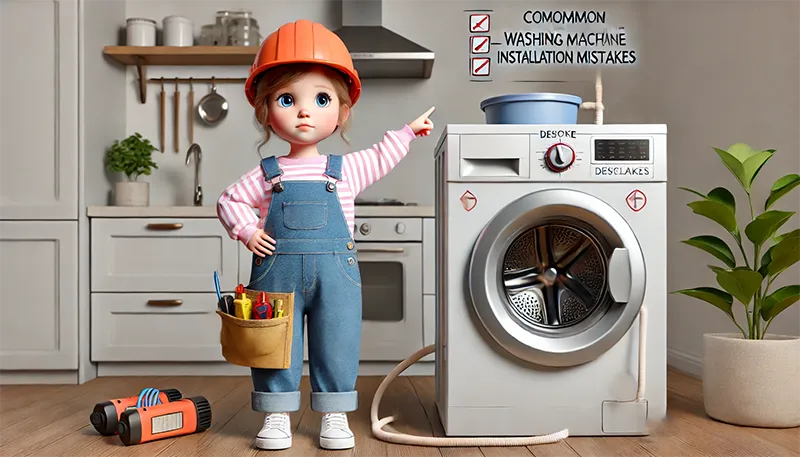Installing a washing machine may seem simple, but a few common washing machine Installation mistakes can lead to leaks, poor performance, and even costly repairs.
Taking the time to avoid these errors will help ensure a smooth, hassle-free setup, keeping your machine running efficiently for years.
Here’s a look at the most common mistakes people make during washing machine installation and how you can avoid them.
Mistake #1: Incorrect Hose Connections
One of the most frequent errors during washing machine installation is connecting the hoses incorrectly. Connecting hoses to the wrong inlets or overtightening can cause persistent leaks and reduce the machine’s efficiency.
- Match Hot and Cold Water Hoses: Be sure to connect the hot water hose to the hot inlet and the cold hose to the cold inlet. Mixing these up can cause issues with water temperature settings.
- Avoid Overtightening: Tightening connections too much can damage the threads on hoses and valves. A firm hand-tight connection is often sufficient.
- Use Teflon Tape: Applying Teflon tape on the threads before tightening can help prevent leaks, ensuring a secure and watertight connection.
Ensuring proper hose connections at the start will save you from frustrating drips and rework later on.
Mistake #2: Poor Drain Hose Positioning
Incorrect drain hose positioning can lead to backflow, flooding, or poor drainage. This part of the installation is essential to get right for smooth, trouble-free use.
- Secure the Drain Hose: Insert the drain hose securely into the standpipe or sink, depending on your setup. Using a hose clamp can prevent it from slipping out during use.
- Create a High Loop: Forming a high loop with the drain hose—securing it higher than the drain outlet—prevents wastewater from flowing back into the machine.
- Avoid Kinks or Bends: Ensure the drain hose isn’t kinked, twisted, or bent, as this can obstruct water flow and cause drainage issues over time.
Positioning the drain hose correctly helps prevent backflow, which can create messes and even lead to mold and mildew growth in the machine.
Mistake #3: Neglecting to Level the Machine
If your washing machine isn’t level, it will make excess noise, move around during spin cycles, and even suffer wear and tear more quickly. Here’s how to ensure your machine is level:
- Use a Level: Place a level on top of the machine and adjust the feet until the machine is balanced on all sides.
- Adjust the Feet: Most machines come with adjustable feet. Rotate them as needed to achieve a stable position.
- Tighten Locknuts: Many washing machine feet have locknuts that you can tighten once the machine is level. This keeps the feet from moving out of place over time.
A properly leveled washing machine will operate more quietly and efficiently, extending its life and saving you from unnecessary repairs.
Mistake #4: Skipping Leak Tests After Setup
After connecting hoses and setting up the drain, it’s essential to test for leaks. Skipping this step can lead to unpleasant surprises later when the machine is in use.
- Turn On Water and Check for Drips: Once the water supply is connected, turn on the water and inspect all hose connections for any signs of leaks. If you see drips, try tightening the connection slightly.
- Run a Short Cycle: Start a short wash cycle to observe the drainage and check for any leaks around the drain hose. Watch for unusual noises or vibrations, which can indicate an issue with leveling or hose connections.
- Adjust Connections as Needed: If you notice any issues, address them immediately by tightening or repositioning connections.
Testing connections before regular use can prevent water damage and save you from dealing with emergency repairs down the road.
Mistake #5: Ignoring Manufacturer Instructions
Each washing machine model can have unique installation requirements. Ignoring the manufacturer’s instructions is a common mistake that can lead to improper installation and potential issues.
- Read the Manual: The manual provides specific guidelines for hose connections, leveling, and drain setup. Taking a few minutes to read it can help you avoid unnecessary mistakes.
- Follow Specific Requirements: Different models may have unique installation needs, such as specific distances from the wall or unique leveling instructions.
- Avoid Generic Setup Steps: While general setup steps are helpful, following your model’s specific instructions ensures a secure, optimal installation.
Taking time to read the instructions can save you from headaches and improve your machine’s performance and lifespan.
FAQs
-
What can happen if I connect the hoses incorrectly?
Incorrect hose connections can cause leaks, affect water temperature settings, and potentially damage your washing machine over time.
-
Why is it important to level the washing machine?
A level washing machine reduces noise and movement during spin cycles, preventing wear and tear and keeping your appliance stable.
-
How do I prevent backflow from the drain hose?
Creating a high loop with the drain hose above the drainpipe prevents wastewater from flowing back into the machine.
-
How often should I check for leaks after installation?
Check for leaks a few days after installation and periodically afterward, especially after moving the machine.
-
Do I really need to follow the manual if I’ve installed machines before?
Yes! Every model may have specific requirements, so following the manual ensures your machine is installed correctly for safe and efficient operation.
Avoiding these common mistakes during washing machine installation can save you time, money, and frustration.
Each step—from securing hose connections to testing for leaks—plays a crucial role in ensuring a stable and long-lasting setup.
By following this guide, you’ll be able to install your washing machine confidently, knowing it’s set up for peak performance and efficiency.



